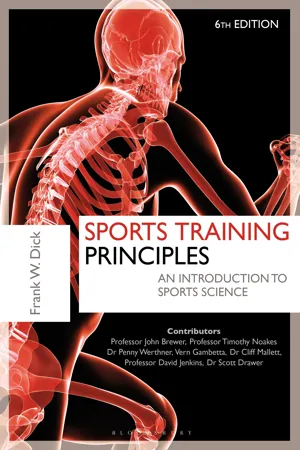
- 432 pages
- English
- ePUB (mobile friendly)
- Available on iOS & Android
About this book
This is the fully revised sixth edition of this ultimate reference tool for all coaches responsible for training athletes to fulfill their performance potential. Written by world-renowned and highly sought after coach and President of the European Athletics Coaches Association, Frank W. Dick, with contributions from Professor John Brewer (St Mary's University, Twickenham, UK), Dr Penny Werthner (University of Calgary, Canada), Dr Scott Drawer (RFU, UK), Vern Gambetta (Sports Training Systems), Dr Cliff Mallett and Professor David Jenkins (University of Queensland, Australia), and Professor Timothy Noakes (University of Cape Town, South Africa), this textbook comprehensively covers the core aspects of sports coaching which can be applied to all sports and disciplines. This new edition has been extensively revised to incorporate the latest theory and practice in sports training and coaching, with supplementary contributions from international experts. The book covers the key sports science topics: Anatomy and physiology; Biomechanics, Psychology; Nutrition; Performance Analysis; Training; and Coaching methods This is a highly recommended resource for students of applied sports science, sports coaching, sports development, PE teachers, fitness advisers, coaches and athletes.
Frequently asked questions
- Essential is ideal for learners and professionals who enjoy exploring a wide range of subjects. Access the Essential Library with 800,000+ trusted titles and best-sellers across business, personal growth, and the humanities. Includes unlimited reading time and Standard Read Aloud voice.
- Complete: Perfect for advanced learners and researchers needing full, unrestricted access. Unlock 1.4M+ books across hundreds of subjects, including academic and specialized titles. The Complete Plan also includes advanced features like Premium Read Aloud and Research Assistant.
Please note we cannot support devices running on iOS 13 and Android 7 or earlier. Learn more about using the app.
Information
PART 1

RODS TO LEVERS

1 | THE WORKING PARTS |


Table of contents
- Cover
- Half-title page
- Title page
- Table of Contents
- Preface
- Introduction
- Part 1 Rods to Levers
- 1 The Working Parts
- 2 Structural Changes in the Growing Child
- 3 Basic Mechanics
- Part 2 The Living Machine
- 4 Nutrition
- 5 The Oxygen Transporting System
- 6 The Working Muscle
- 7 The Fluid Systems
- 8 The Hormones
- 9 Physiological Differences in the Growing Child
- Part 3 Mission Control
- 10 Sport Psychology for Coaches
- 11 Perceptual-Motor Learning
- 12 Psychological Changes and the Growing Child
- Part 4 The Language of Training Theory
- 13 Fitness
- 14 Theory and Practice of Strength Training
- 15 Theory and Practice of Speed Development
- 16 Theory and Practice of Endurance Development
- 17 Theory and Practice of Mobility Development
- 18 Evaluation in Sport
- Part 5 Planning the Programme
- 19 Periodising the Year
- 20 Reflections on Periodisation
- 21 Units, Microcycles, Mesocycles and Macrocycles
- 22 Adaptation to Loading
- 23 Training v Straining
- 24 Competition Period
- 25 Fitting Things Together
- Appendices
- eCopyright